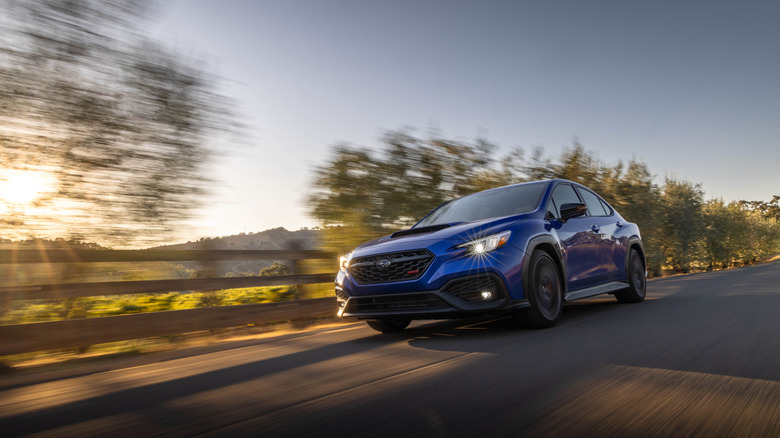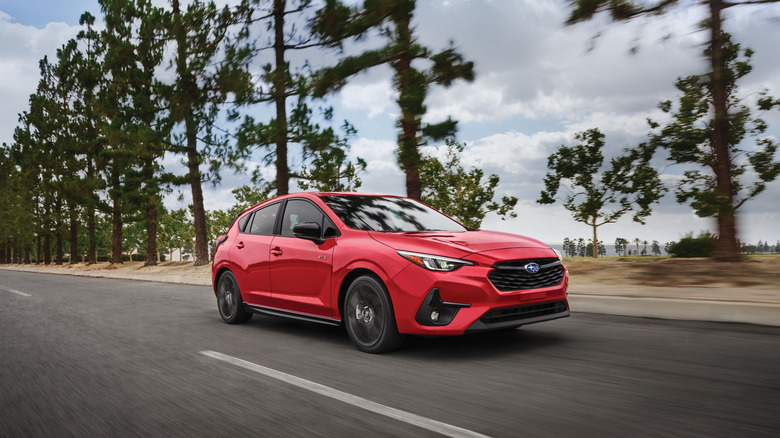What Makes The Subaru WRX Different From The Impreza?
The Impreza and the WRX are close relatives. They use the same platform and have very similar interiors, and this has been the case for a long time. Originally, the WRX (which stands for World Rally Experimental) was a trim level for the Subaru Impreza, before the company separated the two nameplates into standalone models in 2015. With the split between the Impreza and the WRX, there are now some significant distinctions between them that are important to shoppers.
The Impreza is currently available only as a five-door hatchback while the WRX is available only as a four-door performance sedan — so that's a good place to start sorting out the differences. The two compact Subarus also differ in terms of overall performance, styling, pricing, and efficiency. The Impreza is likely to appeal to buyers looking for a more practical and affordable experience, while the WRX aims to steal the hearts of enthusiasts instead.
A basic breakdown of the Impreza
There are three different trim levels for the Impreza: Base, Sport, and RS. All three come standard with all-wheel drive and an automatic continuously variable transmission (CVT). The Base and the Sport trim both get a 2.0-liter four-cylinder boxer engine that makes 152 horsepower and 145 lb-ft of torque. The RS trim is a bit more exciting with its 2.5-liter four-cylinder engine that makes 182 hp and 178 lb-ft. In Car and Driver's performance testing, it went from zero to 60 mph in 7.8 seconds — in comparison, the WRX made the same sprint in 5.5 seconds (more on that later).
During our test of the 2024 Impreza RS, it proved to be an entertaining hatchback to drive with a likable cabin, even if it was a bit mild for our tastes. Behind the rear seats, the Impreza offers 20.4 cubic feet of cargo space — enough for a few suitcases. According to the EPA, the Impreza with the base 2.0-liter engine will return as high as 30 mpg combined (27 city/34 highway) while the 2.5-liter engine drops slightly to 29 mpg combined (26 city/33 highway). Of the two, the Impreza is certainly the less-expensive Subaru. It starts at $24,665 (including $1,170 destination fee), while the topped-out RS sneaks in just under $30,000 ($29,555) before options like the available Harman Kardon stereo or a power moonroof.
How much gusto does the WRX add?
Under the hood of the WRX is a turbocharged 2.4-liter four-cylinder boxer engine that makes 271 horsepower and 258 lb-ft of torque. That's not quite enough power to keep up with class leaders like the Honda Civic Type R or the Toyota GR Corolla, but it's certainly entertaining. In our recent drive of the WRX tS, we found that the lack of power wasn't a big deal: The WRX is plenty gutsy all on its own. As you'd probably expect from a high-performance sedan, fuel economy estimates aren't great. With the six-speed manual transmission, the EPA estimates that the WRX will return 22 mpg combined (19 city/26 highway). Go with the automatic and that estimate drops to 21 mpg combined (18 city/25 highway).
There are several available WRX trim levels: Premium, Limited, GT, and tS. There isn't any overlap between Impreza and WRX prices — the least-expensive WRX is several thousand more than the top Impreza trim. The WRX Premium with the six-speed manual starts at $36,920 (including $1,170 destination fee). The top tS and GT models both have an MSRP of $46,875. Compared to the Impreza, the WRX is a bit down on cargo space, offering just 12.5 cubic feet of storage in the trunk. It's more entertaining to drive, but when it's pitted against the Impreza, the WRX has some significant drawbacks when it comes to practicality and affordability.


